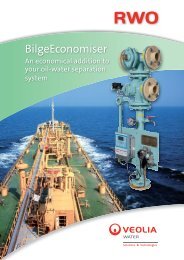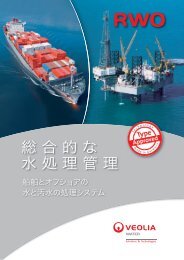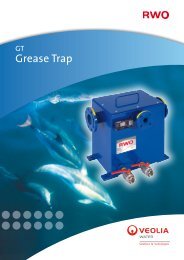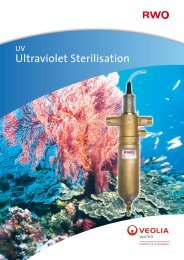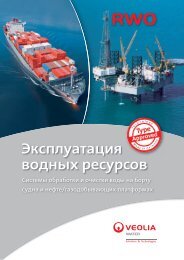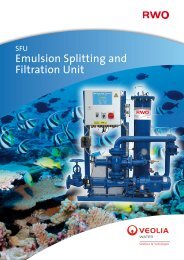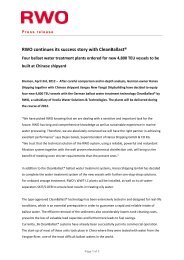the IHS Ballast Water Guide - RWO Marine Water Technology
the IHS Ballast Water Guide - RWO Marine Water Technology
the IHS Ballast Water Guide - RWO Marine Water Technology
You also want an ePaper? Increase the reach of your titles
YUMPU automatically turns print PDFs into web optimized ePapers that Google loves.
<strong>IHS</strong> Fairplay Solutions <strong>Guide</strong> to <strong>Ballast</strong> <strong>Water</strong> Treatment Systems Sponsored by<br />
Stricter rules in <strong>the</strong> USA<br />
The IMO’s <strong>Ballast</strong> <strong>Water</strong> Convention will<br />
eventually apply to most of <strong>the</strong> world, but<br />
some countries have indicated that <strong>the</strong>y may<br />
set <strong>the</strong>ir own rules and a few have already<br />
done so in advance of <strong>the</strong> ratifi cation of <strong>the</strong><br />
IMO convention. The convention is intended<br />
to apply globally, but separate though similar<br />
legislation is making its way through <strong>the</strong> US<br />
legal system.<br />
The USA adopted a unique set of rules<br />
governing both its own fl agged ships and<br />
foreign vessels in US ports and within <strong>the</strong><br />
country’s territorial waters. These contained<br />
diff erences from <strong>the</strong> discharge standards<br />
in <strong>the</strong> IMO regulations. Under United<br />
States federal rules a two-phase system was<br />
proposed. In <strong>the</strong> fi rst phase, <strong>the</strong> quality<br />
standards were to be much <strong>the</strong> same as <strong>the</strong><br />
IMO convention standards. The second phase,<br />
however, originally proposed for introduction<br />
in 2016, set far more stringent and highly<br />
controversial water standards.<br />
An example of <strong>the</strong> diff erence between<br />
<strong>the</strong> US Phase 2 and IMO convention rules<br />
was <strong>the</strong> standard for living organisms larger<br />
than 50μm. While <strong>the</strong> IMO (and US Phase 1)<br />
standards require fewer than 10 organisms<br />
per cubic metre of ballast, US Phase 2 rules<br />
set a maximum of one organism/100m 3 .<br />
In November 2011, after individual US<br />
states threatened to impose <strong>the</strong>ir own<br />
requirements, federal lawmakers approved<br />
a single nationwide ballast water discharge<br />
standard that conforms to performance<br />
standards set by <strong>the</strong> IMO. The Commercial<br />
Vessel Discharges Reform Act of 2011 was<br />
approved by <strong>the</strong> US House of Representatives<br />
on 13 October. It had to pass a vote in <strong>the</strong><br />
Senate before it could be signed into law.<br />
The legislation amends <strong>the</strong> federal Clean<br />
<strong>Water</strong> Act by prohibiting <strong>the</strong> Environmental<br />
Protection Agency (EPA) from permitting<br />
individual states to impose requirements on<br />
top of federal standards. The act also requires<br />
<strong>the</strong> US Coast Guard (USCG) to set a schedule<br />
for vessel owners to install ballast water<br />
treatment technology that has been certifi ed<br />
to <strong>the</strong> new standard.<br />
All ships entering US waters must comply<br />
with <strong>the</strong> vessel general permit (VGP),<br />
which sets out best practices, training and<br />
documentation rules for 26 incidental vessel<br />
discharges, including ballasting, deck runoff ,<br />
bilgewater and greywater. Its regulators<br />
include <strong>the</strong> US Coast Guard and <strong>the</strong> EPA.<br />
Alleging that <strong>the</strong> VGP violated <strong>the</strong> Clean<br />
<strong>Water</strong> Act by failing to regulate ballast<br />
Phase 1: Implementation schedule for Phase 1 ballast-water management programme<br />
<strong>Ballast</strong>-water capacity (m 3 ) Construction date Compliance date<br />
New vessels (all capacities) On or after 1 December 2013 On delivery<br />
Existing vessels < 1,500 Before 1 December 2013 First drydocking after 1 Jan 2016<br />
Existing vessels 1,500–5,000 Before 1 December 2013 First drydocking after 1 Jan 2014<br />
Existing vessels > 5,000 Before 1 December 2013 First drydocking after 1 Jan 2016<br />
8 © <strong>IHS</strong> Global Limited 2012<br />
006_009_BW1204.indd 8 21/03/2012 18:28:31



